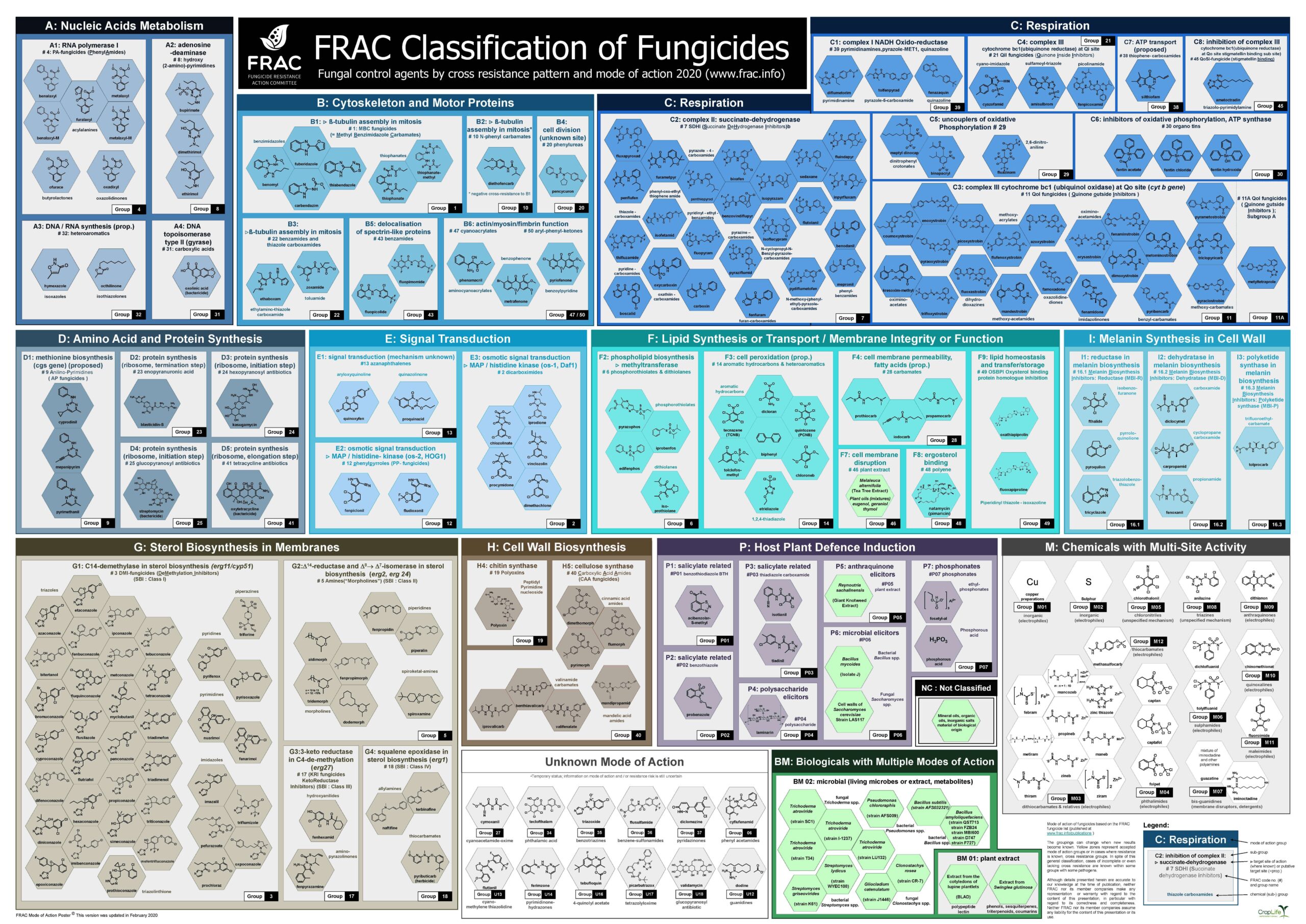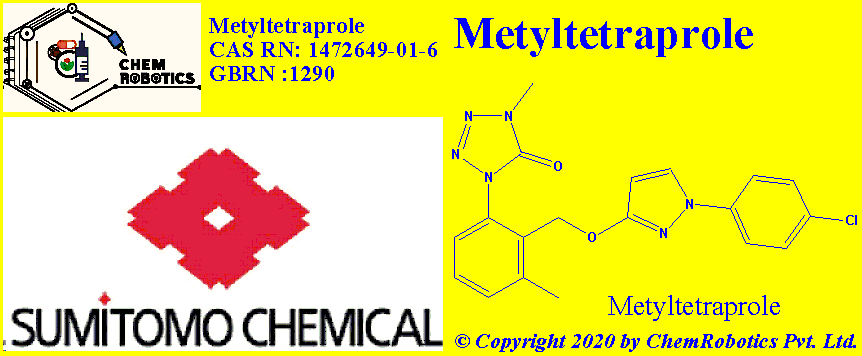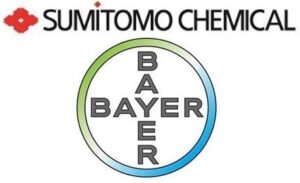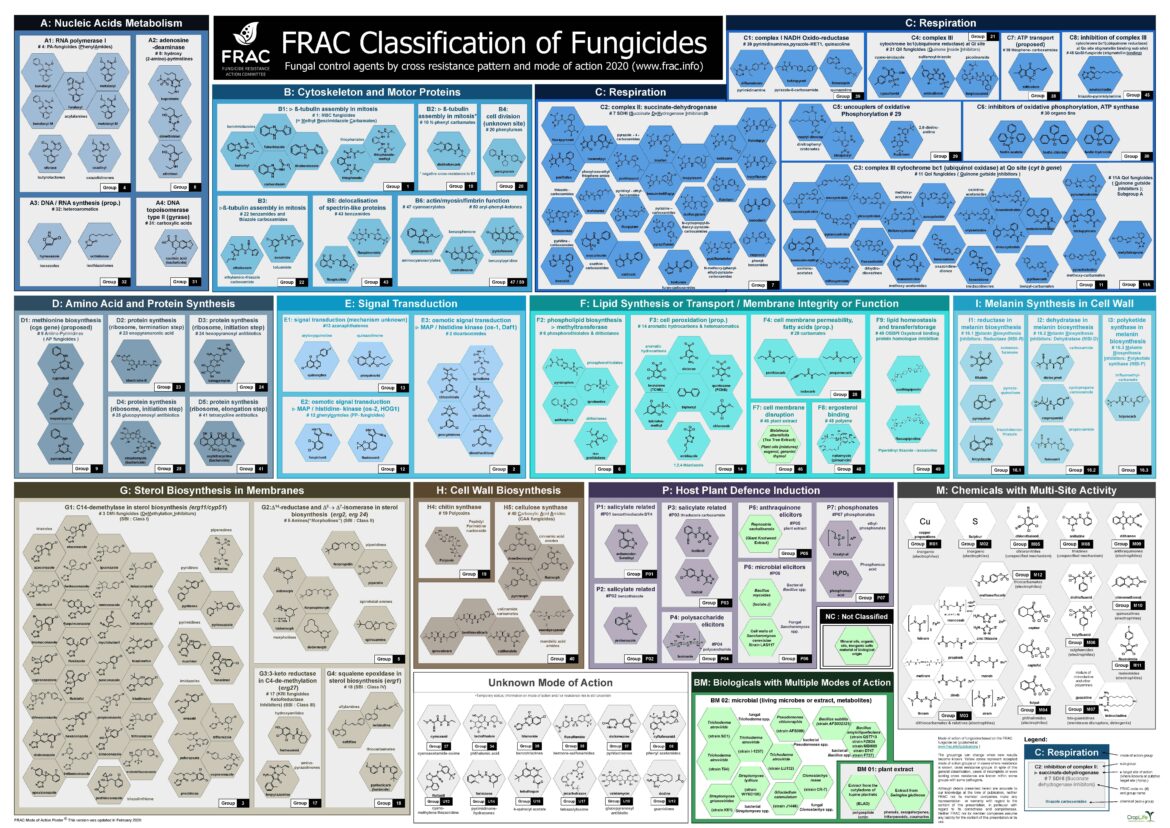FRAC POSTER © 2020 PUBLISHED WITH SUMITOMO PROPRIETARY FUNGICIDE MOLECULE METYLTETRAPROLE

FRAC Poster 2020
On June 29, 2020 – FRAC published a new poster © 2020, wherein 11A QoI fungicides (Quinone outside Inhibitors); Subgroup A – newly added MOA class. Metyltetraprole (Sumitomo Fungicide) is the only member currently for the 11A group.
Metyltetraprole is a quinone outside inhibitor (QoI), it is a fungicide that can be used to control a broad range of diseases, including Septoria leaf blotch in wheat.
Chemically Metyltetraprole belongs to phenylpyrazole fungicides or tetrazolinone fungicides class. Metyltetraprole is the first member of a new generation of QoIs, tetrazolinone fungicides. Metyltetraprole is the first of a new innovative generation of QoIs and represents a new option for fungicide spraying programs, which shows stable efficacy in greenhouses and fields, even in the presence of G143A QoI-resistant mutants.

Metyltetraprole
CAS RN. 1472649-01-6
IUPAC Name: 1-[2-({[1-(4-chlorophenyl)-1H-pyrazol-3-yl]oxy}methyl)-3-methylphenyl]-1,4-dihydro-4-methyl-5H-tetrazol-5-one.
Innovator: Sumitomo
Developer: Sumitomo collaborated Bayer & BASF
IP Scenario: Metyltetraprole is a Sumitomo proprietary fungicide molecule, discovered in 2013. Sumitomo protected compound by filing international patent application WO2013162072.
Sumitomo collaborated with BASF, Nufarm, and Bayer & for Metyltetraprole Fungicide development

Sumitomo & Nufarm Collaboration
In June 2018 Sumitomo Chemicals and BASF announced a joint development program for Metyltetraprole under the trade name (PAVECTO), along with an EU registration application submission (by Sumitomo).
In September 2018, Sumitomo announced a further collaboration with Nufarm, to facilitate the introduction of PAVECTO into European cereal markets.
Features Applications Collaboration with Bayer:

Sumitomo & Bayer Collaboration
Highly effective against major diseases such as soybean rust Submitted in Japan, Argentina, the U.S., Canada, and Brazil in 2017, to be launched in 2022 or later, with other countries also planned.
Sumitomo also collaboration with Bayer on new fungicidal mixtures in Brazil in June 2017. Both companies separately develop and sell unique formulations with the Metyltetraprole fungicide compound.
Features Applications Collaboration with BASF:

Sumitomo & BASF Collaboration
Highly effective against major plant diseases such as septoria. Also effective against strains resistant to existing fungicides submitted in Japan and the EU in 2018, to be launched in 2021 or later, with other countries also planned.
Global collaboration with BASF to develop new fungicide in June 2017. Both companies separately develop and sell unique formulations with the Metyltetraprole fungicide compound.
About FRAC:
The organization known as the Fungicide Resistance Action Committee (FRAC) was established by industry and research scientists to be an overseeing group to monitor fungicide resistance and provide guidelines for the development of products with long term utility.
Fungicides have become an integral part of efficient food production. The loss of a fungicide to agriculture through resistance is a problem that affects us all. FRAC works to prolong the effectiveness of fungicides liable to encounter resistance problems and to limit crop losses should resistance appear.
This committee established the FRAC code, which identifies different target sites within specific modes of action for all active ingredients. Usually, there is a small rectangular box on every fungicide label where the FRAC number is located.
When the FRAC code shows only one number, it implies that the fungicide contains a single active ingredient but if a fungicide contains two active ingredients, two numbers will be shown. For example, a FRAC code shown as ‘group 7’ indicates that the fungicide is a succinate dehydrogenase inhibitor (SDHI) whereas groups 11 are Quinone outside inhibitors (QoI which includes strobilurins). However, if both 7 and 11 appear in the label, it means the fungicide has active ingredients belonging to the two groups.
Some specific examples of fungicide resistance that have been seen in different crops. If a fungus is resistant to a specific fungicide active ingredient within a FRAC Code, then it will most likely be resistant to all fungicides with the other active ingredients in the same FRAC Code.
FRAC Poster 2020 publication web link is provided herein: https://www.frac.info/docs/default-source/publications/frac-mode-of-action-poster/frac-moa-poster-2020.pdf?sfvrsn=d364499a_2
FRAC Code List ® 2020: https://www.frac.info/docs/default-source/publications/frac-code-list/frac-code-list-2020-final5d632b2c512362eb9a1eff00004acf5d.pdf?sfvrsn=f940499a_2
For More details: Subscribe AgroPat* (http://chemrobotics.com/)
-
AgroPat provides techno-legal solutions to Agrochemical Discovery and Generic industry. (https://www.chemrobotics.com/agropat-lighter/login)
-
AgroPat platforms cover more than 4500 Active Ingredients (Al’s) with all information including synthesis (ROS), formulation, combination, innovator, patents including product patent, developer, utmost important biology data containing spectrum, MoA, DFU, toxicity, which can play a major role in decision making for any individual /company/ university/ industry.
-
-
- AgroPat Open Access – Free access to everyone,
- AgroPat Lite – With limited information as per business function needs,
- AgroPat ultimate – With all technical and business information,
-
-
-
Provide aboriginal information, which enables product developers to know about the state of the art in relevant subject matter, which includes innovator Patent / Non-Patent literature, which is critical for the generic industry.
-
Indian Pesticide Database (IPD) offers pesticide product registration/approval Information in various categories including Section 9(3), Section 9(3B), Section 9(4) and Bio-pesticides (https://www.chemrobotics.com/agropat/#/ipd)
-
“Global Agro Product Directory” is an Agrochemical product directory, wherein all approved agrochemical products can be tracked. (https://www.chemrobotics.com/pesticides-directory/)
-
MRL database has the maximum residue limits (MRLs) allowed for most pesticides used on major fruit and vegetable export crops and commodities in different counties like the USA, Europe, Japan, Canada, China, India, Australia, Israel, Malaysia, and Taiwan. Exporters can use this database to find out the residue limits in global markets. (https://www.chemrobotics.com/agropat/#/mrldir)
-
“Brazil-Ag-Pedia” is a Brazil Agrochemical product directory, wherein all approved agrochemical products in Brazil can be tracked with all relevant information (https://www.chemrobotics.com/agropat/#/brazil_ag_pedia)


